David's Astronomy Pages (Projects)
Cataclysmic Variable Stars
Rotating
Variables
Variable
Stars
Home
Page
Eclipsing
Variables
David's Astronomy Pages (Projects)
|
Rotating Variables |
Variable Stars |
Home Page |
Eclipsing Variables |
Cataclysmic Variable Star Types (CV's) Main Project Stars 
AM AM Herculis stars (Type AM) | AM Her | 
N Novae (Type N) | Nova Delphini (2013) | V2491 Cyg (2008) | V1722 Aql (2009) | GK Per | 
SN Supernovae (Type SN) | SN 2006x | SN 2008ax | 
UG Dwarf Novae (Type UG) 
UGSS SS Cygni stars (Type UGSS) | SS Cyg | U Gem | CY Lyr | RU Peg | 
UGSU SU Ursae Majoris stars (Type UGSU) | SU UMa | FO And | ER UMa subtype | RZ LMi | ER UMa | UGWZ WZ Sge stars (UGWZ) | WZ Sge | UGZ Z Camelopardalis stars (Type UGZ) | RX And | TT Ari | SY Cnc | CN Ori | 
ZAND Z Andromedae stars (Type ZAND) | Z And | CI Cyg | 
Other/Mixed Types UX - novalike variable (UX UMa subtype) | UX UMa | VY - novalike variable (VY Scl subtype) | KR Aur | Interacting binary white dwarfs (Type IBWD) | AM CVn | Other Stars (Type *) | FG Sge | 
More Information Catalog and Atlas of Cataclysmic Variables
[http://archive.stsci.edu/prepds/cvcat/index.html
Novae, dwarf novae and closely related objects that undergo outbursts that are typically capable of repetition. They are normally interacting binaries comprising a cool stars usually near the main sequence , which fills its Roche lobe and loses matter in the direction of a white dwarf companion, usually forming and accretion disk. Most CV's show outbursts, typically repeated, which may be due to the burning of hydrogen to helium in a thermonuclear runaway on the surface of the white dwarf (novae), or to the pulsed release, in the form of light and heat, of gravitational energy from material falling towards the white dwarf (dwarf novae).
AM Her type variables; close binary systems consisting of a dK-dM type dwarf and of a compact object with strong magnetic field, characterized by variable linear and circular polarization of light. The total range of light variations may reach 4-5 mag V.
Back to Top
| AM Her (Hercules) |
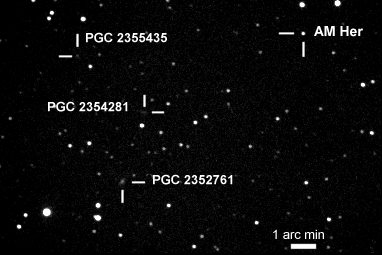
|
| Annotated CCD Image 2 x 180 sec exposure (average combine), 2x2 binning, C Filter 2008-09-20 23:37 UT (#303185-86) |
| AM Her - reference stars |
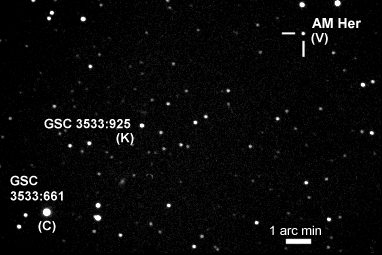
|
| Annotated CCD Image 2 x 180 sec exposure (average combine), 2x2 binning, C Filter 2008-09-20 23:37 UT (#303185-86) |
Back to Top
Novae. Close binary systems with orbital periods from 0.05 to 230 days. One of the components of these systems is a hot dwarf star that suddenly, during a time interval from one to several dozen or several hundred days, increases its brightness by 7-19 mag in V, then returns gradually to its former brightness over several months, years, or decades. Small changes at minimum light may be present. Cool components may be giants, subgiants, or dwarfs of K-M type. The spectra of novae near maximum light resemble A-F absorption spectra of luminous stars at first. Then broad emission lines (bands) of hydrogen, helium, and other elements with absorption components indicating the presence of a rapidly expanding envelope appear in the spectrum. As the light decreases, the composite spectrum begins to show forbidden lines characteristic of the spectra of gas nebulae excited by hot stars. At minimum light, the spectra of novae are generally continuous or resemble the spectra of Wolf-Rayet stars. Only spectra of the most massive systems show traces of cool components. Some novae reveal pulsations of hot components with periods of approximately 100 s and amplitudes of about 0.05 mag in V after an outburst. Some novae eventually turn out to be eclipsing systems. According to the features of their light variations, novae are subdivided into fast (NA), slow (NB), very slow (NC), and recurrent (NR) categories.
NA
Fast novae displaying rapid light increases and then, having
achieved maximum light, fading by 3 mag in 100 or fewer days (GK Per);
NB
Slow novae that fade after maximum light by 3 mag in >=
150 days (RR Pic). Here the presence of the well-known "dip" in the light
curves of novae similar to T Aur and DQ Her is not taken into account: The rate
of fading is estimated on the basis of a smooth curve, its parts before and after
the "dip" being a direct continuation of one another;
NC
Novae with a very slow development and remaining at maximum
light for more than a decade, then fading very slowly. Before an outburst these
objects may show long-period light changes with amplitudes of 1-2 mag in V (RR Tel);
cool components of these systems are probably giants or supergiants, sometimes semiregular
variables, and even Mira variables. Outburst amplitudes may reach 10 mag. High excitation
emission spectra resemble those of planetary nebulae, Wolf-Rayet stars, and symbiotic
variables. The possibility that these objects are planetary nebulae in the process
of formation is not excluded;
NL
Novalike variables, which are insufficiently studied objects
resembling novae by the characteristics of their light changes or by spectral features.
This type includes, in addition to variables showing novalike outbursts, objects
with no bursts ever observed; the spectra of novalike variables resemble those of
old novae, and small light changes resemble those typical for old novae at minimum
light. However, quite often a detailed investigation makes it possible to reclassify
some representatives of this highly inhomogeneous group of objects into other types;
NR
Recurrent novae, which differ from typical novae by the fact
that two or more outbursts (instead of a single one) separated by 10-80 years have
been observed (T CrB).
Back to Top
| Nova Delphini (2013) (Delphinus) Nova Delphini was discovered on 14th August 2013 by Japanese observer Koichi Itagaki at magnitude +6.8. Koichi had imaged the same field the day before and nothing was visible at the same location. The progenitor star was identified from archive images as being magnitude +16.9 The image below was taken 25 days after discovery when nova had faded
to around +7.5 |
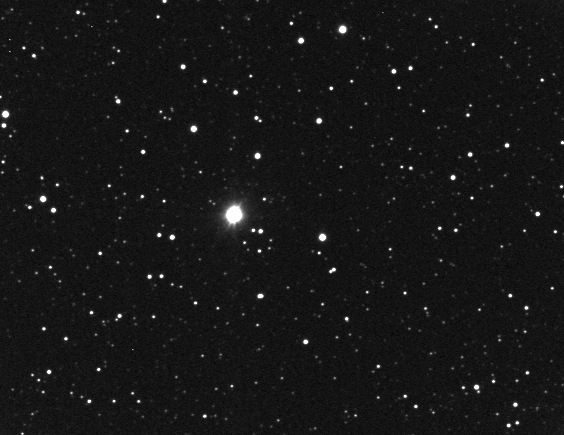
|
| CCD Image (cropped) 5 x 5 sec exposure (average combine), 3x3 binning, C Filter 2013-09-08 22:19hUT (#546057-61) 12" LX200R (at f/9.7) + ST-10XME |
Back to Top
|
V2491 Cyg (Cygnus) |
||
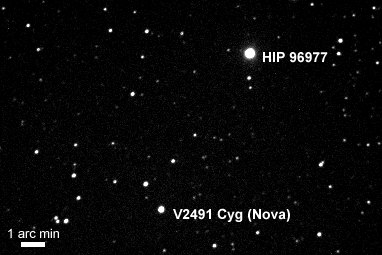 |
||
| Annotated CCD Image 20s exposure, 2x2 binning, C Filter 2008-04-14 23:30hUT (#281142) |
||
| Sequence of CCD images of V2491 Cyg taken at varying dates after discovery | ||
| 4.25 days (mag +8.5) |
Pre-Nova (DSS image) |
|
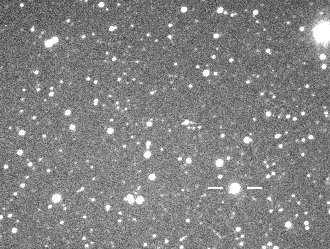 |
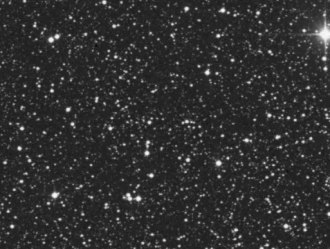 |
|
| 3x20s exposure (average combine), 2x2 binning, C Filter 2008-04-14 23:48hUT (#281164-66) |
DSS image Same field of view as image to left [ image from http://archive.stsci.edu/cgi-bin/dss_form ] |
|
| 22.3 days (mag +10.8) |
59.3 days (mag +14.0) |
|
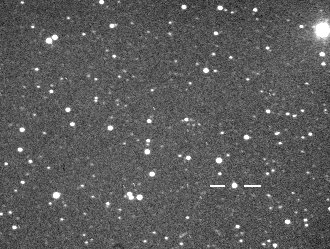 |
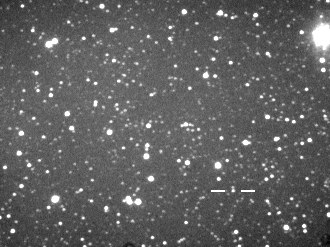 |
|
| 3 x 120s exposure (average combine), 2x2 binning, C Filter 2008-05-03 00:56hUT (#285129-31) |
3 x 120s exposure (average combine), 2x2 binning, C Filter 2008-06-08 23:56hUT (#290054-56) |
|
| 71.3 days (mag +14.4) |
83.3 days (mag +14.8) |
|
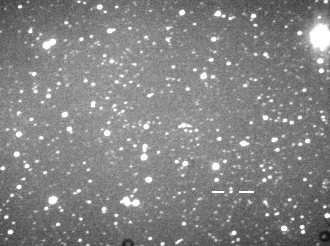 |
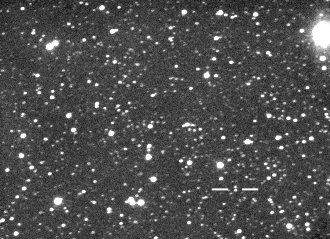 |
|
| 3 x 120s exposure (average combine), 2x2 binning, C Filter 2008-06-20 23:47hUT (#291042-44) |
3 x 120s exposure (average combine), 2x2 binning, C Filter 2008-07-02 23:54hUT (#293040-42) |
|
|
415 days (mag < +16 ) |
Pre-Nova (DSS image) |
|
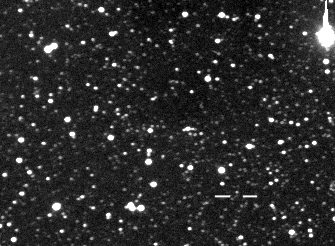 |
 |
|
| 3 x 45s exposure (average combine), 3x23 binning, C Filter 2009-05-31 01:02hUT (#371200-02) 12" LX200 R + ST-10XME |
DSS image Same field of view as image to left [ image from http://archive.stsci.edu/cgi-bin/dss_form ] |
|
| V2491 Cyg - Light Curves showing decline from discovery (+7.7) down to final measurement (+14.8) |
||
|
|
||
|
|
||
|
|
||
|
V2491 Cyg - Reference Stars |
||
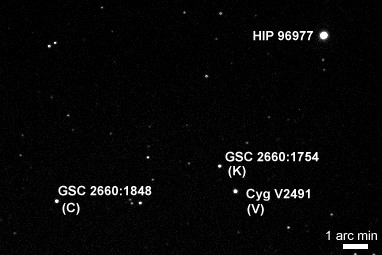 |
||
| Annotated CCD Image 15s exposure, 2x2 binning, V Filter 2008-04-14 23:51hUT (#281171) |
||
| Identification of precursor star to V2491 Cyg Nova | ||
| V2491 Cyg 59.3 days after discovery |
Pre-Nova (DSS image) |
|
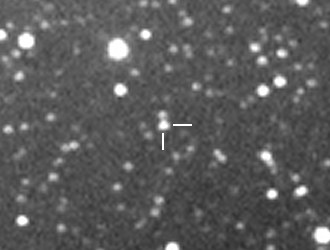 |
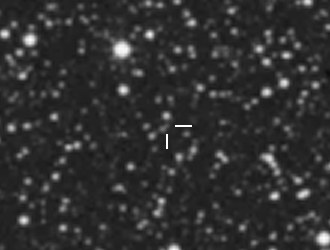 |
|
| 3 x 120s exposure (average combine), 2x2 binning, C Filter 2008-06-08 23:56hUT (#290054-56) |
DSS image Same field of view as image to left [ image from http://archive.stsci.edu/cgi-bin/dss_form ] |
|
Back to Top
| V1722 Aql / Nova Aquilae 2009 (Aquila) Nova discovered by Koichi Nishiyama, & Fujio Kabashima (Japan) at magnitude 10.9 on 2009-12-14.40 Image (2009-12-26.77) was taken 12.4 days after discovery. V filter images taken at same show the nova with magnitude +12.32 |
|
|
| Annotated CCD Image (cropped) 3 x 15sec (average combine), 2x2 binning, C Filter 2009-12-26 18:32 h UT (#408034-42) 12" LX200R (at f/5.7) + ST-10XME |
| V1722 Aql- Detail |
|
|
| CCD Image (cropped) Image details as above Alternate Black/White range |
| V1722 Aql- Reference Stars |
| C Star : 000-BJS-297 / GSC 1599:3910, (V Mag 11.571) K Star : 000-BJS-296 / GSC 1599:3038, (V Mag 11.358) V filter image showing the nova with magnitude +12.32 (check star +11.42 vs expected value of +11.36) |
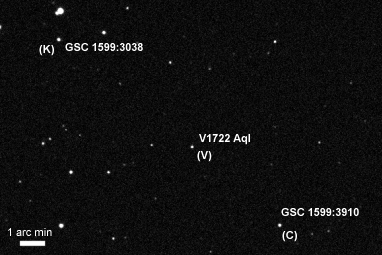
|
| Annotated CCD Image (cropped) 5s exposure, 2x2 binning, V Filter 2009-12-26 18:31 h UT (#408036) 12" LX200R (at f/5.7) + ST-10XME |
Back to Top
|
GK Per (Perseus) |
| GK Per - reference stars |
|
|
|
Annotated CCD Image |
|
|
| GK Per - earlier image (2008-09-27) |
|
|
| Annotated CCD Image 3 x 30s exposure (average combine), 2x2 binning, C filter, 2008-09-27 21:41h UT (#306152-58) |
| GK Per - variation |
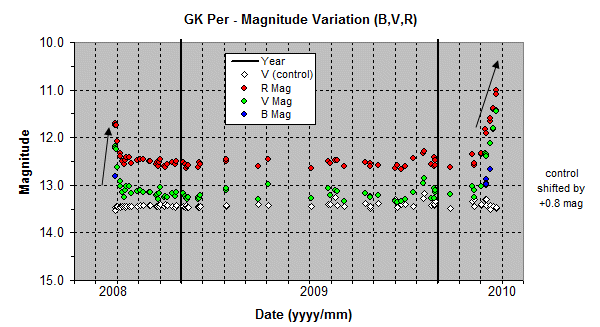
|
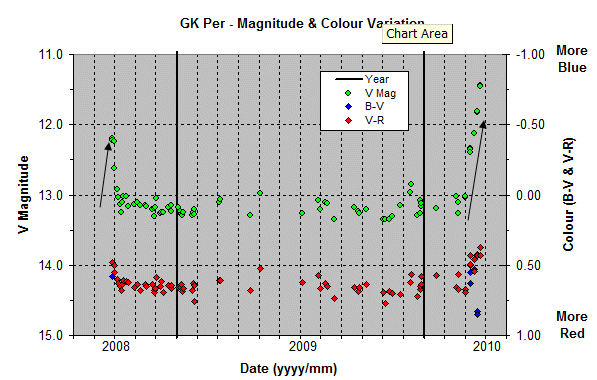
|
| Mar 2010 Outburst |
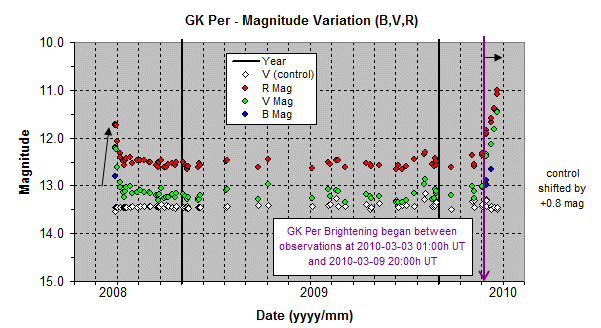
|
Back to Top
Supernovae (B Cas, CM Tau). Stars that increase, as a result of an outburst,
their brightnesses by 20 mag and more, then fade slowly. The spectrum during an
outburst is characterized by the presence of very broad emission bands, their widths
being several times greater than those of the bright bands observed in the spectra
of novae. The expansion velocities of SN envelopes are in the thousands of km/s.
The structure of a star after outburst alters completely. An expanding emission
nebula results and a (not always observable) pulsar remains at the position of the
original star. According to the light curve shape and the spectral features, supernovae
are subdivided into types I and II.
SNI
Type I supernovae.
Absorption lines of Ca II, Si, etc., but no hydrogen lines are present in the spectra.
The expanding envelope almost lacks hydrogen. During 20-30 days following maximum
light, the brightness decreases by approximately 0.1 mag per day, then the rate
of fading slows and reaches a constant value of 0.014/day;
SNII
Type II supernovae. Lines of hydrogen and other elements
are apparent in their spectra. The expanding envelope consists mainly of H and He.
Light curves show greater diversity than those of type I supernovae. Usually after
40-100 days since maximum light, the rate of fading is 0.1 mag per day.
Back to Top
|
SN 2006x in M100 (Ursa Major) |
||
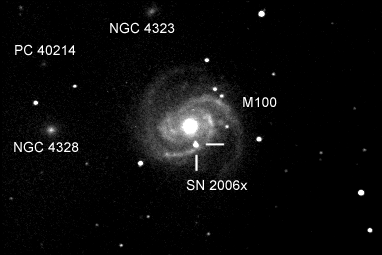 |
||
| Annotated CCD Image 5 x 2 min exposure (average combine), 2x2 binning, C Filter 2006-02-20 23:17h UT (#115064-68) |
||
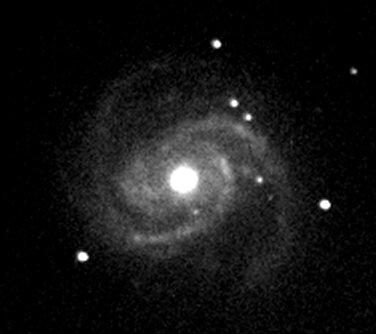 |
M100 Reference Image, 2004 Pre-SN 2006x CCD Image (200% size) |
|
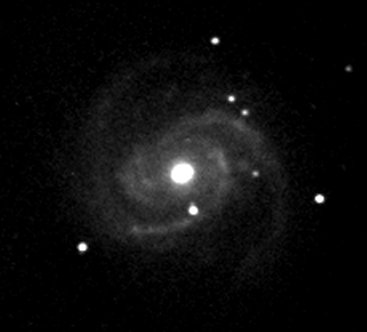 |
SN 2006x, 2006-02-20 16 days after discovery SN Est. Mag +13.7 (C Filter) CCD Image (200% size) 5 x 2 min exposure (average combine), 2x2 binning, C Filter 2006-02-20 23:17h UT (#115064-68) |
|
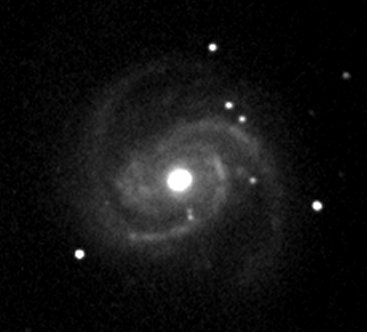 |
SN 2006x, 2006-04-23 78 days after discovery SN Est. Mag +15.7 (C Filter) CCD Image (200% size) 5 x 2 min exposure (average combine), 2x2 binning, C Filter 2006-04-23 22:26h UT (#116082-86) |
|
Back to Top
|
SN 2008ax in NGC 4490 (Canes Venatici) Image below (2008-03-08.03) was taken 4.6 days after discovery. |
||
|
NGC 4490 before SN2008ax |
NGC 4490 with SN 2008ax |
|
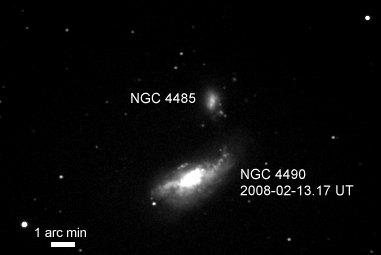 |
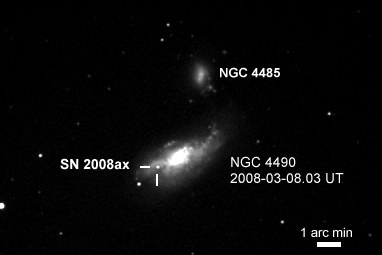 |
|
| Annotated CCD Image 7 x 120s exposure (average combine), 2x2 binning, C Filter 2008-02-14 04:00 hUT (#263704-10 |
Annotated CCD Image 7 x 120s exposure (average combine), 2x2 binning, C Filter 2008-03-08 00:48 hUT (#273136-42) |
|
Back to Top
Dwarf Nova, sometimes call U Geminorum stars, but is a term also for used for types UGSS and UGSU only, and not UGZ. Close binary systems consisting of a dwarf or subgiant K-M star fillings its inner Roche lobe, and a white dwarf surrounded by an accretion disk. Orbital periods range from 0.05 - 0.5 days. From time to time the brightness of the system increases rapidly by several magnitudes, and after days or weeks it returns to its original state. The pauses between two consecutive outbursts for a given star may vary over a wide range , but every star is characterised by a certain mean value of the cycle length. Longer cycles tend to be followed by outbursts of greater amplitude. Some systems are eclipsing and the primary minimum appears to be due to the eclipse of a hot spot on the accretion disk, where matter falls in a gaseous stream from the donor star.
U Gem variables may be subdivided into three types:
SS Cyg (Type UGSS)
SU UMa (Type UGSU)
Z Cam (Type UGZ)
Dwarf Nova in which visual brightness increases by 2 - 6 mag in 1 - 2 days, and the star returns to its original brightness over several days. Cycle lengths range from 10 to several thousand days. Examples SS Cyg, U Gem.
Measurements being made in B, V, R & I filters as part of ongoing study.
|
SS Cyg (Cygnus) |
||
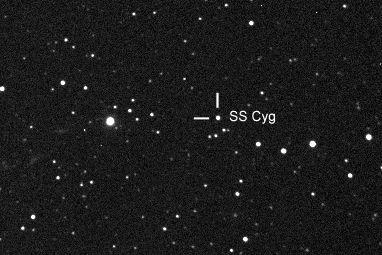 |
||
| Annotated CCD Image 20s exposure, 2x2 binning, C Filter 2006-05-24 23:48 hUT (#127066) |
||
|
SS Cyg - Reference Stars |
||
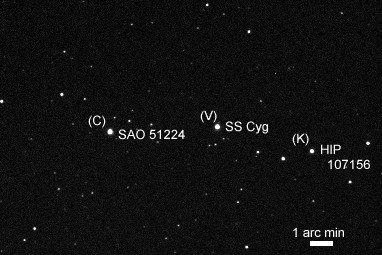 |
||
| SS Cyg variation | ||
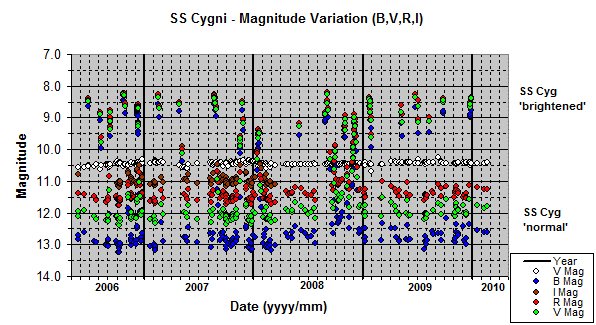 |
||
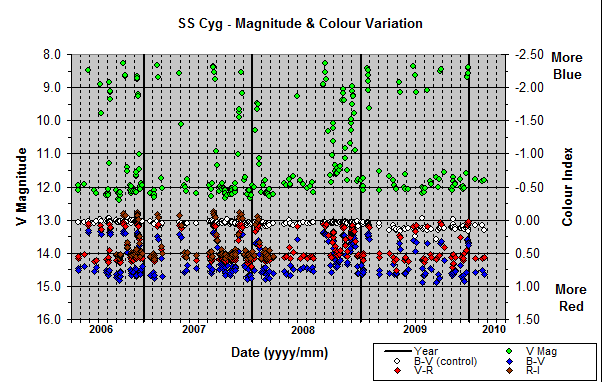 |
||
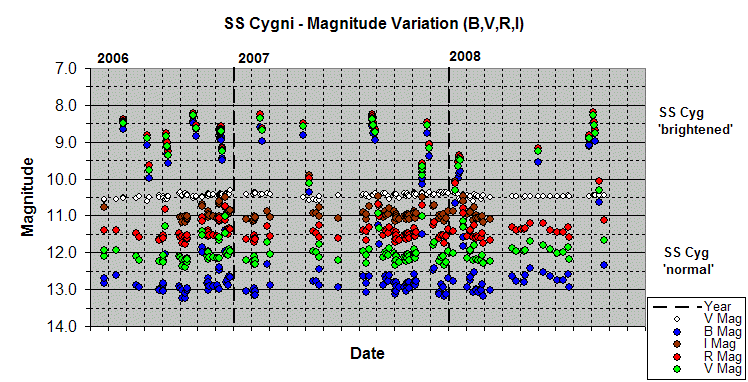 |
||
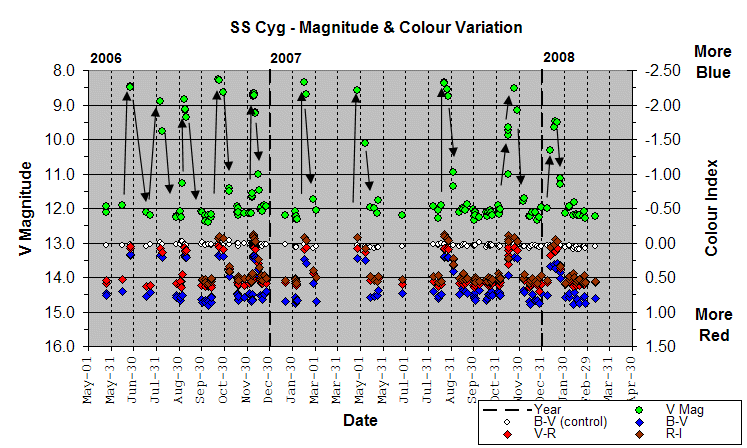 |
||
| SS Cyg variation by colour band (QC Plots) | ||
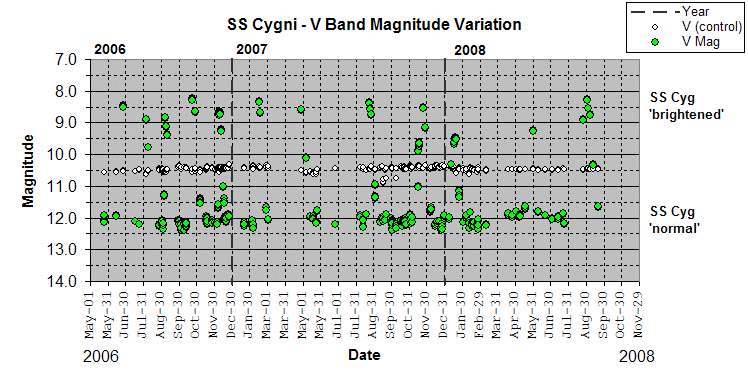 |
||
|
Animated CCD Sequence (V Band) showing +3.5 mag brightening of SS Cyg |
||
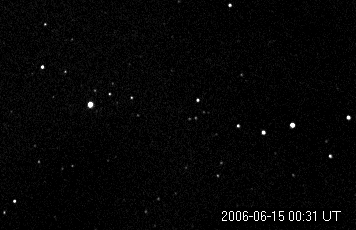 |
||
| Animated CCD Image 3 frames (3 x 30s,median combine), V filter 2006-06-15 (#128034-36), V mag +13.0 2006-06-25 (#129134-36), V Mag + 9.0 2006-07-17 (#130025-27), V Mag +13.2 |
||
| SS Cyg - Light Variation - December 2006 Dataset comprising 15 nights of observations |
||
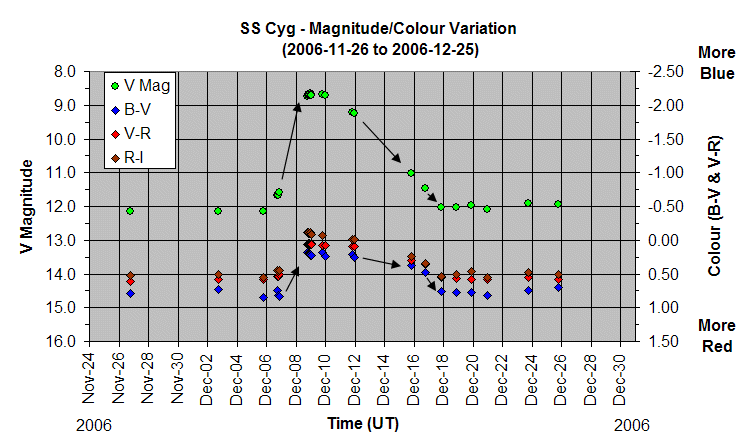 |
||
|
|
||
|
SS Cyg - Light Variation - August/September
2007 |
||
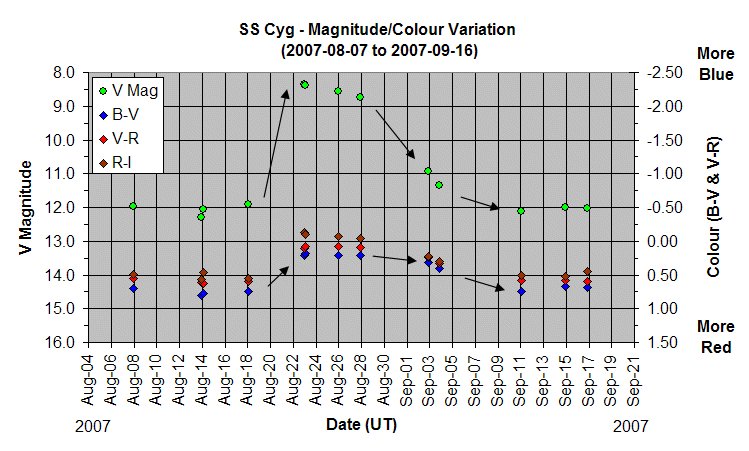 |
||
|
SS Cyg - Light Variation (Aug 2007-Jan 2008) |
||
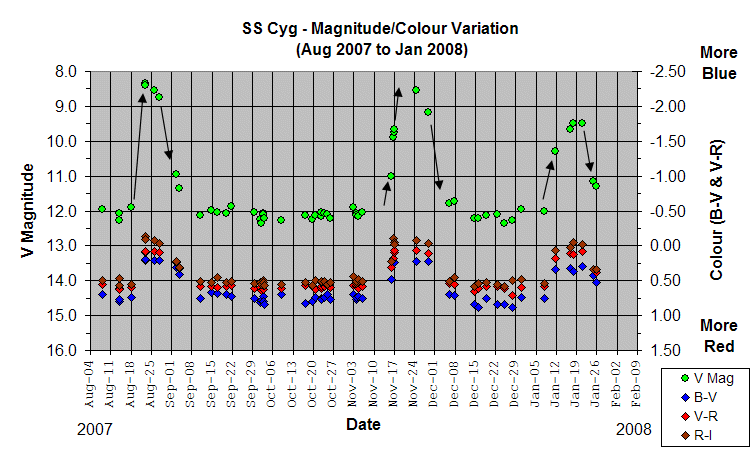 |
||
|
|
||
|
SS Cyg - Magnitude and Colour Variation between 2006-05-24 and 2007-09-15 |
||
|
|
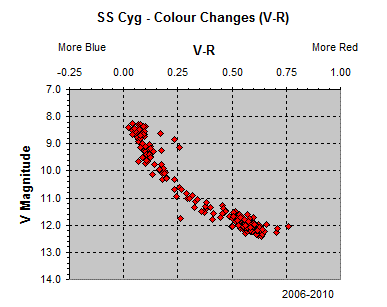 |
|
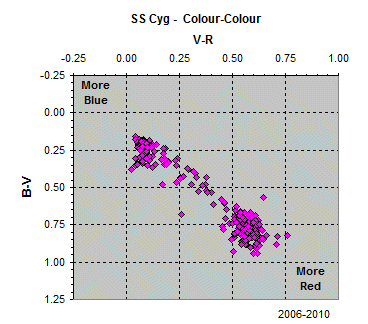 |
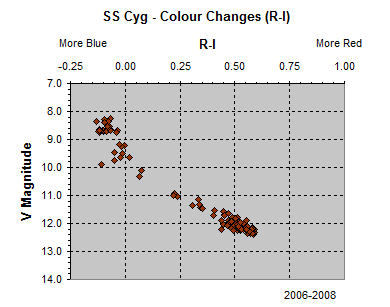 |
|
|
SS Cyg (Cygnus) |
||
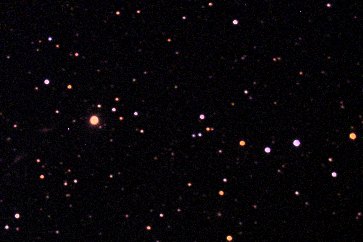 |
||
| Approximate Colour CCD Image (LRGB) Luminance : 2 x 20s exposure (average combine, C Filter), Red : 3 x 30s exposure (average combine, R Filter), Green : 3 x 30s exposure (average combine, V Filter), Blue : 3 x 60s exposure (average combine, B Filter) 2 x 2 binning 2006-05-24 23:52 hUT (#127066-76) |
||
| Plots of 2006 Data | ||
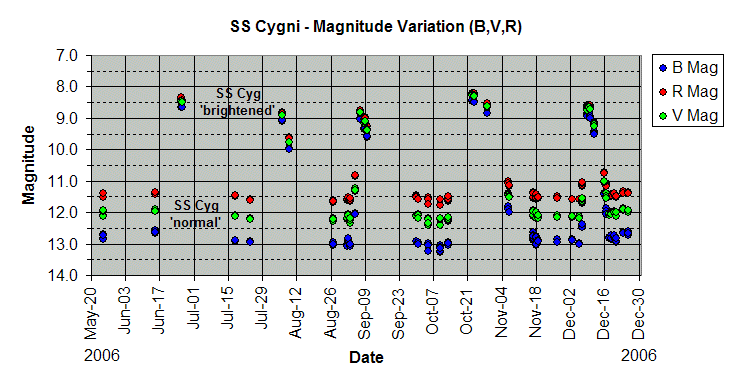 |
||
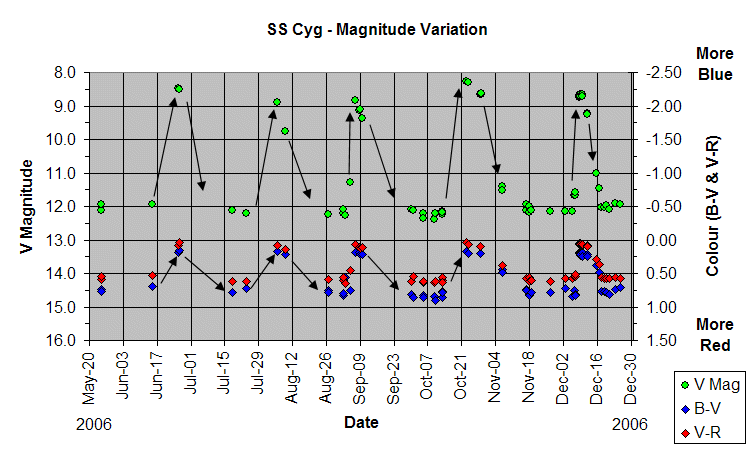 |
||
| SS Cyg variation by colour band (QC Plots) | ||
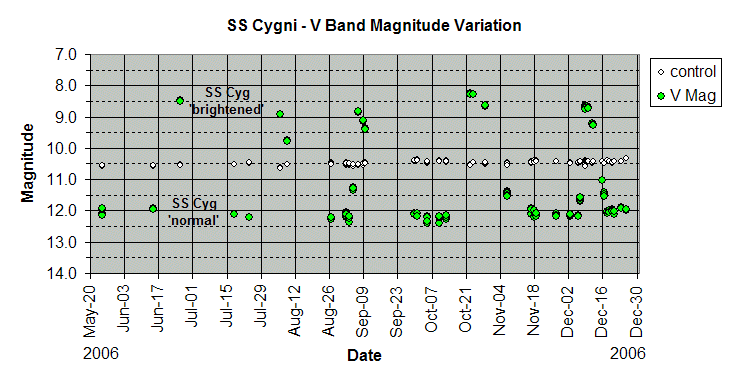 |
||
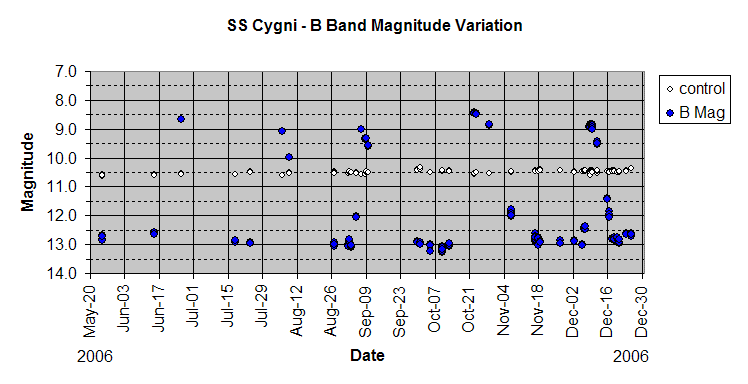 |
||
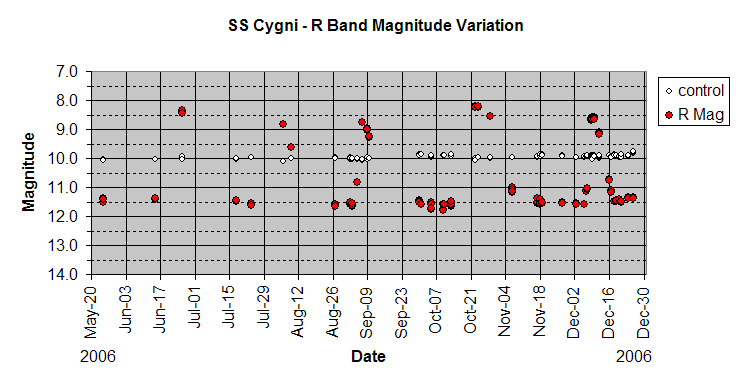 |
||
Back to Top
|
U Gem (Gemini) |
|
|
|
U Gem at Mag +13.5 |
|
|
| CCD Image 3 x 20s exposure (average combine), 2x2 binning, C filter, 2007-02-04 20:47h UT (#174176-86) |
|
|
| U Gem - Approximate Colour |
|
|
| Approximate Colour CCD Image (LRGB) Luminance: av 3 x 20s (C Filter), Red: av 3 x 20s (R Filter) Green : av 3 x 30s (V Filter), Blue : av 3 x 60s (B Filter) 2007-02-04 20:47h UT (#174176-89) |
|
|
| U Gem - Baseline Image U Gem : Estimated V Mag +13.65 [ using reference Star : GSC 1375:804 V Mag 11.27 from UCAC 2.0 ] |
|
|
| CCD Image 3 x 30s (average combine), 2x2 binning, V Filter 2007-02-04 20:47h UT (#174178-88) |
| U Gem variation |
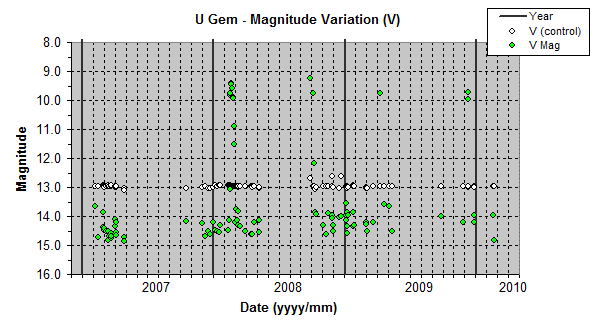
|
| U Gem Eruption - Feb 2008 |
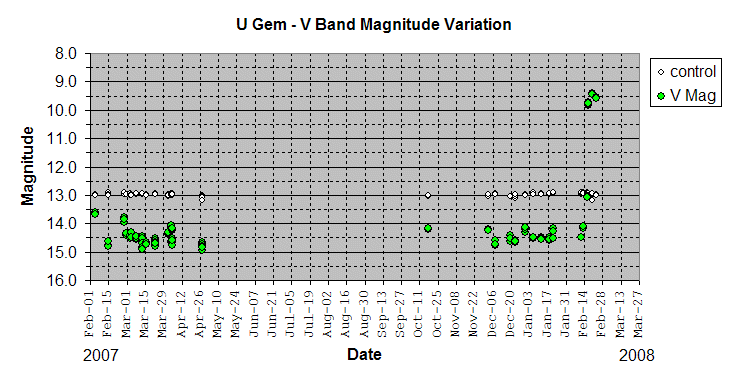
|
Back to Top
|
CY Lyr (Lyra) |
|
|
| Annotated CCD Image 3 x 60s sec exposure (average combine), 2x2 binning, V Filter 2007-10-22 23:47 h UT (#224278-80) [ AAVSO Star Chart for CY Lyr ] |
|
|
|
CY Lyr - Reference Stars |
|
|
| Annotated CCD Image (Image details as above) |
|
|
|
Earlier Image of CY Lyr from 2006 |
|
|
| Annotated CCD Image 3 x 120s sec exposure (average combine), 2x2 binning, V Filter 2006-09-08 22:58 h UT (#141205-07) [ AAVSO Star Chart for CY Lyr ] |
|
|
| CY Lyr variation |
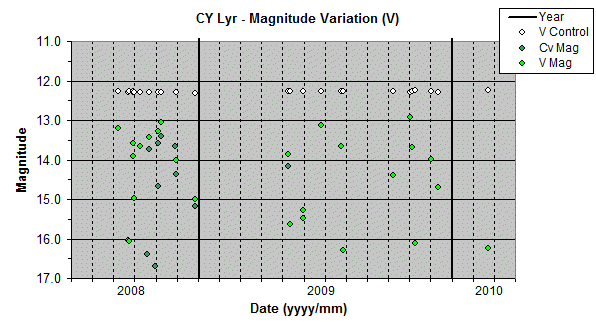
|
Back to Top
|
RU Peg (Pegasus) |
|
|
| CCD Image 30s exposure, 2x2 binning, C Filter 2006-11-16 21:52h UT (#152216) |
| RU Peg outburst (2002) - north down |
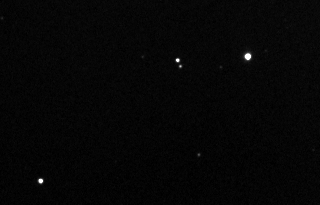
|
| RU Peg - Photometry Results |
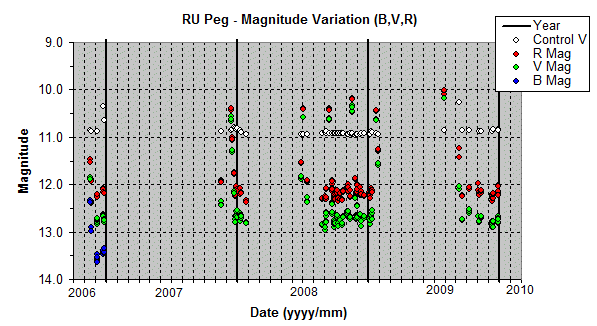
|
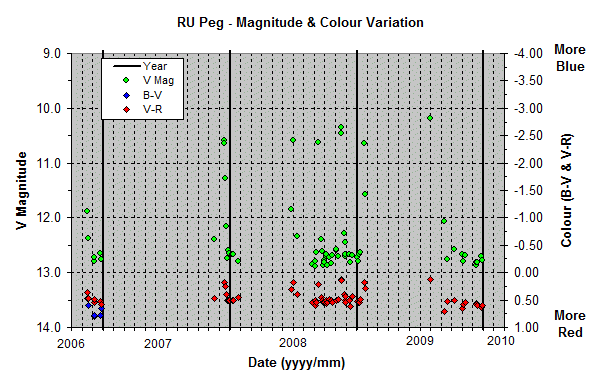
|
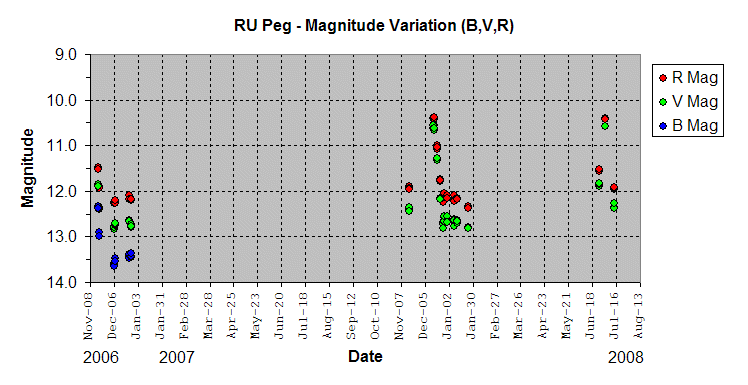
|
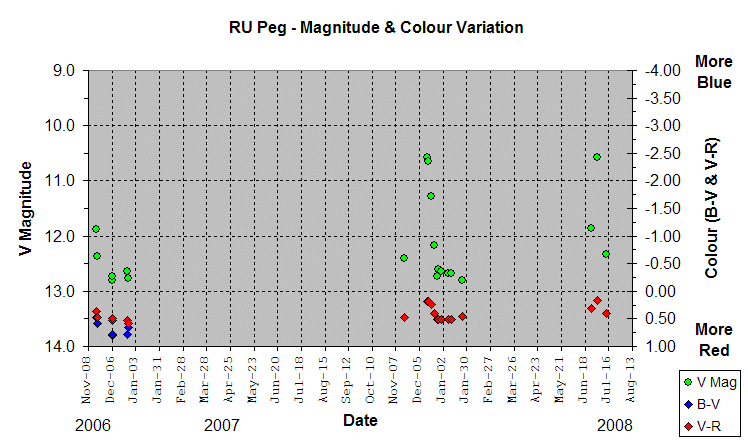
|
Back to Top
Dwarf Nova characterised by the presence of two types of outburst: normal ones and supermaxima. Normal outbursts are similar to those of UGSS stars. Supermaxima are typically brighter than normal ones by 2 mag., more than five times longer and at least three times less frequent than normal maxima. During supermaxima the light curves show superimposed periodic oscillations (superhumps), whose period is close to the orbital one and whose visual amplitude is about 0.2 - 0.3 mag. The orbital periods are shorter than 0.1 day. Examples SU UMa.
|
SU UMa (Ursa Major) |
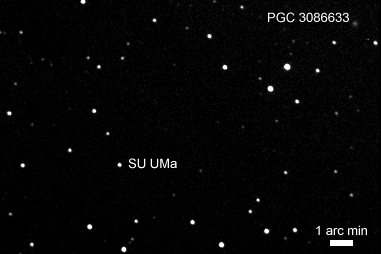
|
| Annnotated CCD Image 3 x 60s exposure (average combine), 2x2 binning, C filter, 2007-03-12 23:59h UT (#182288-92) |
| SU UMa reference stars |
|
|
| Annotated CCD Image 120s exposure, 2x2 binning, V filter, 2007-03-12 23:57h UT (#182289) |
| SU UMa Photometry |
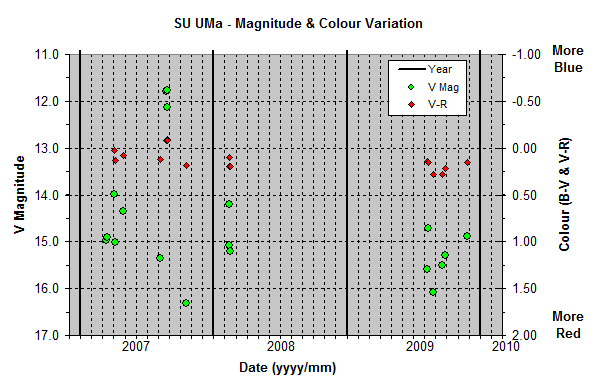
|
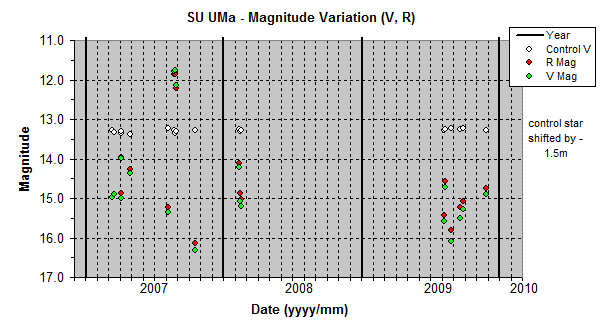
|
|
Animation sequence of images showing variation in SU UMa |
|
|
| Animated CCD Images 180 sec exposure, 2x2 binning, V Filter 2007-04-28 (#192248), 2007-08-08 (#203184), 2007-08-22 (#206056) 2007-08-25 (#207032), 2007-10-17 (#221109) |
Back to Top
|
RZ LMi (Leo Minor) |
|
|
| CCD Image 3 x 60s exposure (average combine), 2x2 binning, C filter, 2007-02-04 22:37h UT (#174319-25) |
|
|
| Annotated CCD Image 180s exposure, 2x2 binning, C filter, 2007-03-12 22:46h UT (#182245) |
| RZ LMi Light Curves |
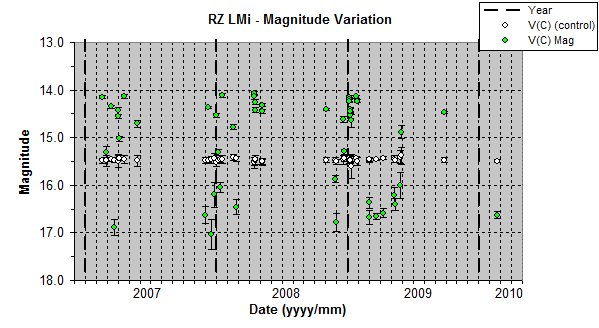
|
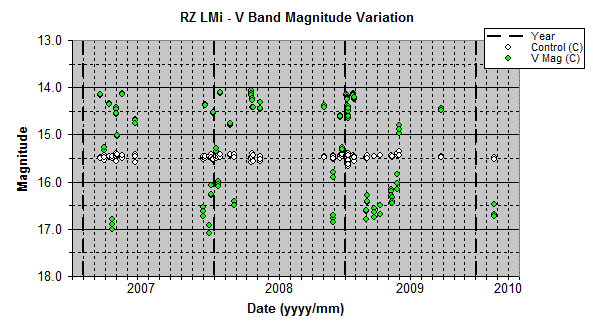
|
Back to Top
|
ER UMa (Ursa Major) |
|
|
| CCD Image 60s exposure, 2x2 binning, C filter, 2007-02-04 23:31h UT (#174370) |
| ER UMa - Reference Stars |
|
|
| CCD Image 180s exposure, 2x2 binning, V filter, 2007-03-12 23:33h UT (#182273) |
| ER UMa Variation (2007) |
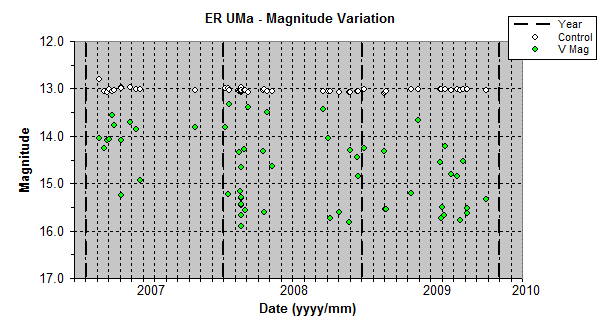
|
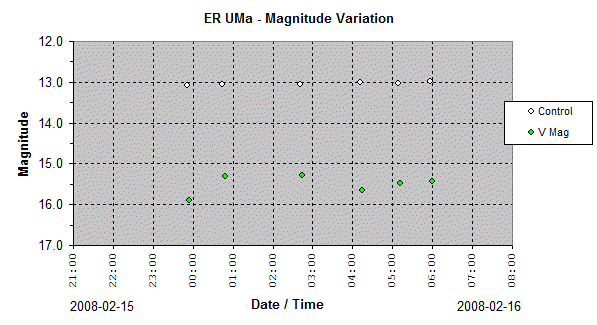
|
Back to Top
|
FO And (Andromeda) |
|
|
| Annotated CCD Image 120s sec exposure, 2x2 binning, C Filter 2008-12-02 20:28 h UT (#330090) |
|
|
|
FO And - reference stars |
|
|
| Annotated CCD Image Image details as above |
Back to Top
Dwarf Nova. Examples WZ Sge
| WZ Sge (Sagitta) WZ Sge has been described as the King of Cataclysmics. Although outbursts are rare they are understood to be spectacular when they do occur, with rapid nova-like brightening and interestingly superhumps, eclipses and a long decay profile [ VSNet WZ Sge Page ] GCVS Catalog details :UGSU+E+ZZ (+7.0 to +15.53) Outbursts in 1978, 2001 |
| WZ Sge - Reference Stars |
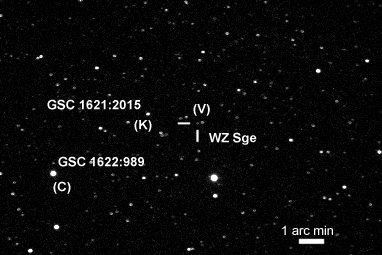
|
| Annotated CCD Image 120 sec exposure, 2x2 binning, V Filter 2008-09-22 21:20h UT (#304061) |
| WZ Sge - detail WZ Sge measured mag +15.2 |
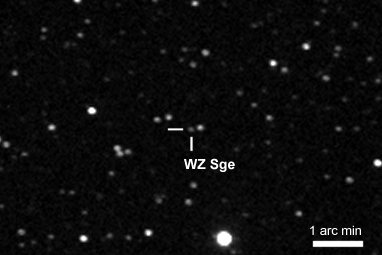
|
| Annotated CCD Image (200% size, cropped) 3 x 120 sec exposure (average combine), 2x2 binning, V Filter 2008-09-22 21:18h UT (#304059-61) [for comparison see outburst image of WZ Sge by G. Masi ] |
Back to Top
UGZ stars show cyclic outbursts but differ from UGSS stars in that sometimes after outburst they do not return to their original brightness but remain at an intermediate magnitude for the duration of several cycles. The cycle lengths are from 10 to 40 days, an dthe visual amplitudes are from 2 to 5 mag. Examples Z Cam, TT Ari
|
RX And (Andromeda) |
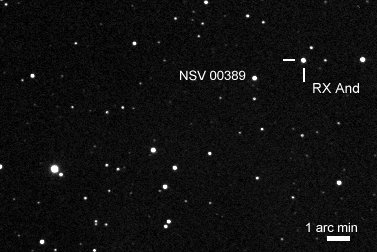 |
| Annotated CCD Image 3 x 30 sec exposure (average combine), 2x2 binning, C Filter 2007-10-23 00:01hUT (#224288-94) |
|
|
|
RX And - Reference Stars |
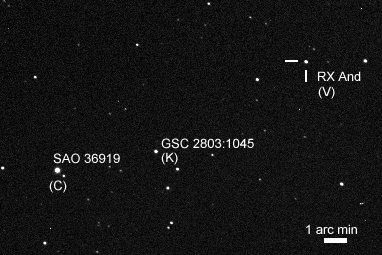 |
| Annotated CCD Image 45 sec exposure, 2x2 binning, V Filter 2007-10-22 23:59hUT (#224289) |
|
|
|
Earlier Images of RX And from 2002 |
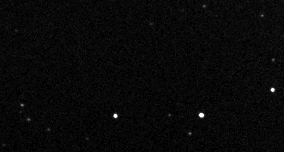 |
| Animated CCD Image (from 2002-10-03 to 2002-11-24) |
| RX And Photometry Results |
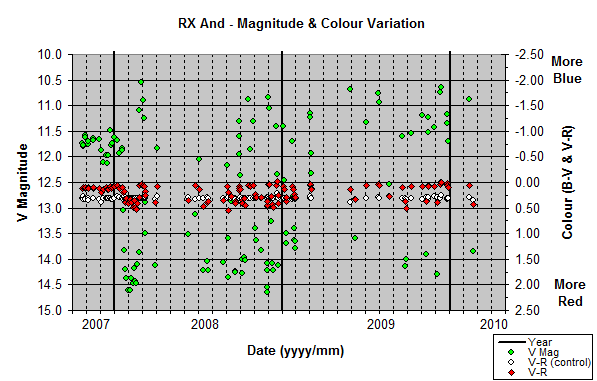
|
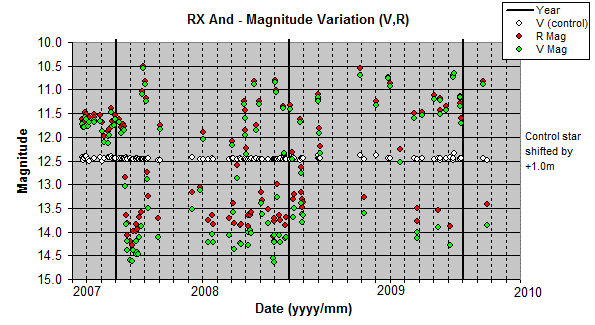
|
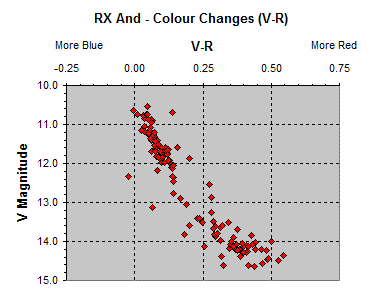 |
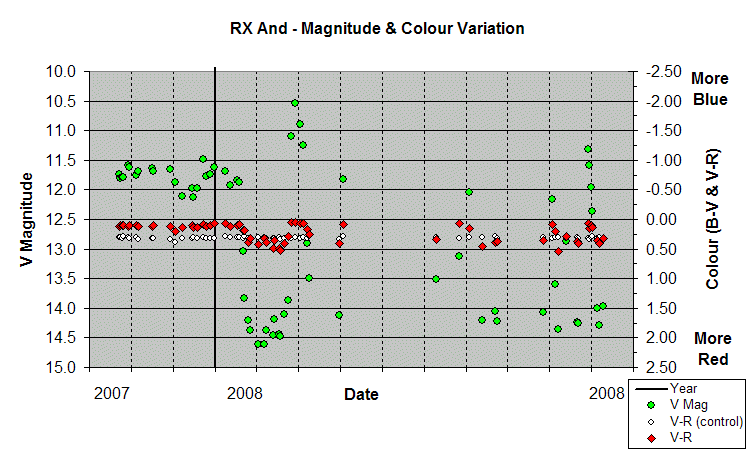
|
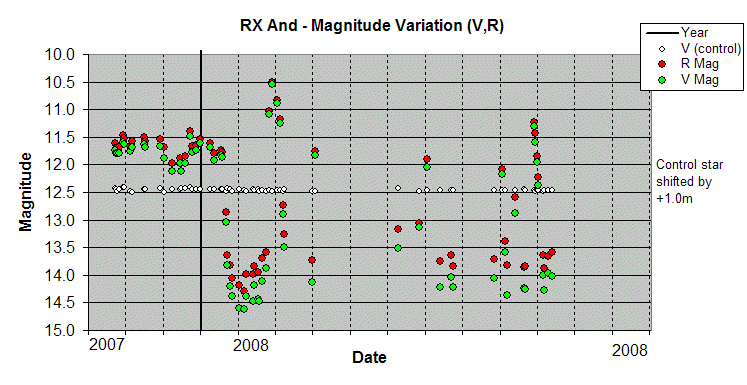
|
| NSV 389 Photometry Results |
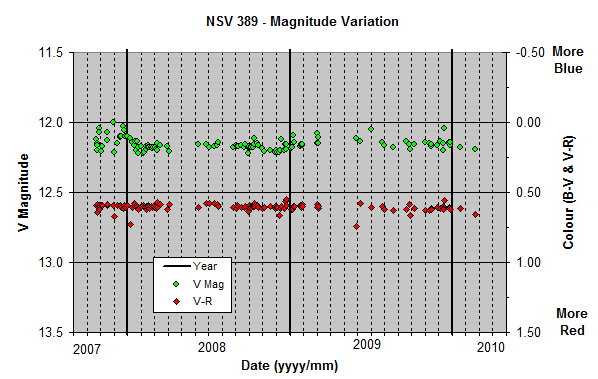
|
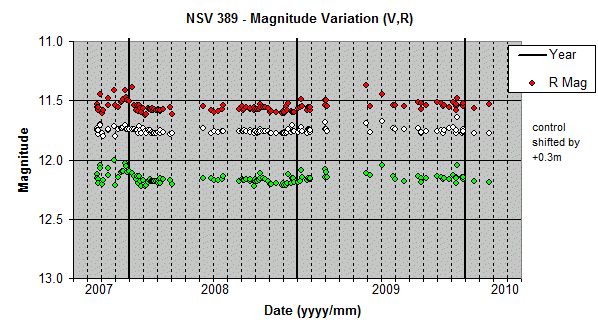
|
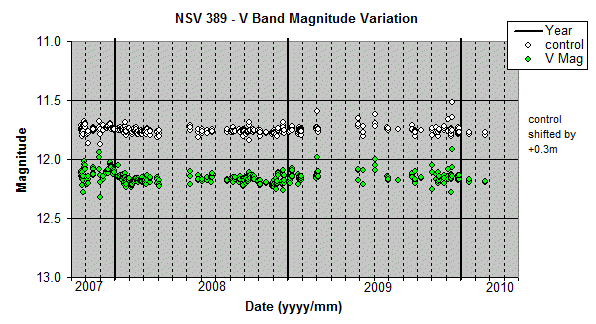
|
Back to Top
|
TT Ari (Aries) |
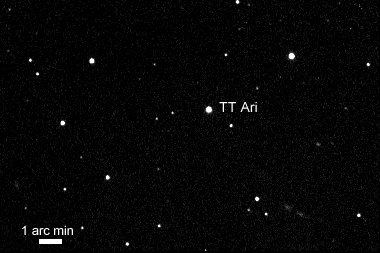 |
| Annotated CCD Image 3 x 30 sec exposure (average combine), 2x2 binning, C Filter 2007-10-22 23:33hUT (#224259-65) |
|
|
|
TT Ari with several distant galaxies |
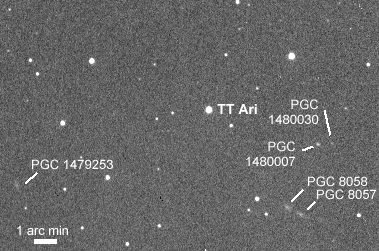 |
| Annotated CCD Image (Image details as above) |
|
|
|
TT Ari - Reference Stars |
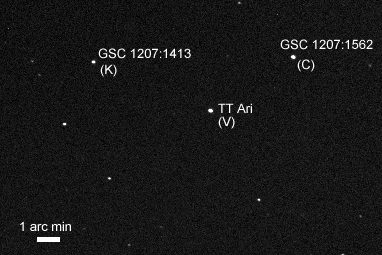 |
| Annotated CD Image 45 sec exposure, 2x2 binning, V Filter 2007-10-22 23:31hUT (#224260) |
| TT Ari Photometry Results |
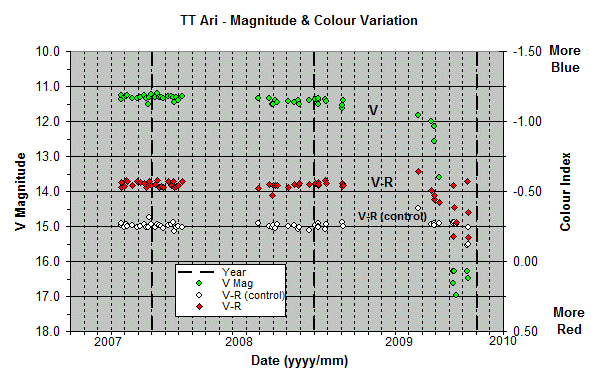 |
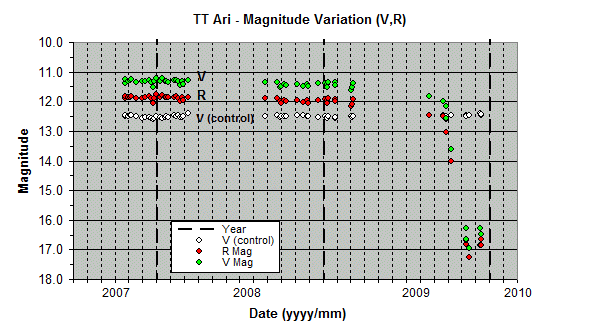 |
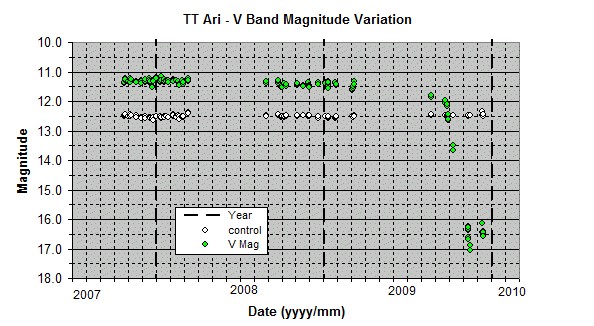 |
Back to Top
|
SY Cnc (Cancer) |
|
|
| Annotated CCD Image 3 x 60s exposure (average combine), 2x2 binning, C filter, 2007-03-12 21:48h UT (#182198-202) |
| SY Cnc - reference stars |
|
|
| Annotated CCD Image 120s exposure, 2x2 binning, V filter, 2007-03-12 21:47h UT (#182199) |
| SY Cnc Variation (2007) |
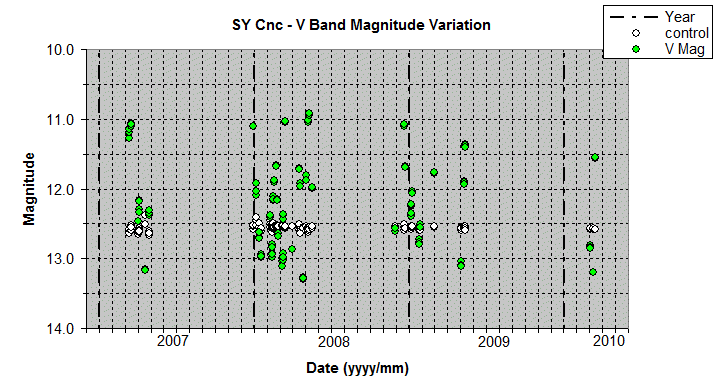
|
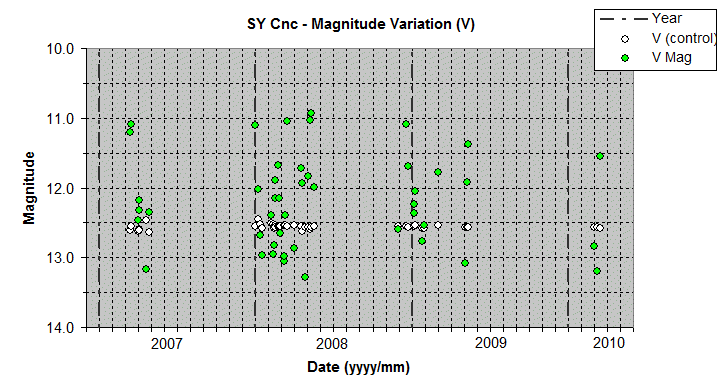
|
Back to Top
|
CN Ori (Orion) |
|
|
| Annotated CCD Image 3 x 45s sec exposure (average combine), 2x2 binning, C Filter 2008-11-28 02:12 h UT (#326479-85) |
|
|
|
CN Ori - reference stars |
|
|
| Annotated CCD Image 90s sec exposure, 2x2 binning, V Filter 2008-11-28 02:13 h UT (#326483) |
| CN Ori Cnc Variation (2008-2009) |
Back to Top
Close binaries consisting of a hot star, a star of late spectral type and an extended envelope excited by the hot star's radiation. The combined brightness varies irregularly with a visual amplitude up to 4 mag. This is a very inhomogeneous class of objects. Examples Z And.
| Z And (Andromeda) |
||
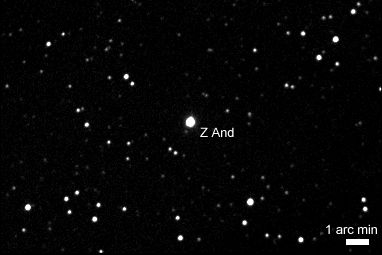
|
||
| CCD Image |
||
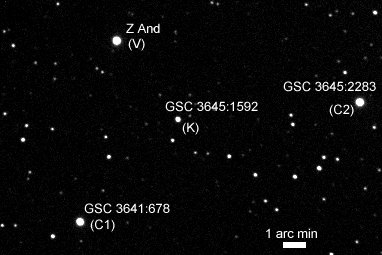
|
||
| Photometry V & B Bands | ||
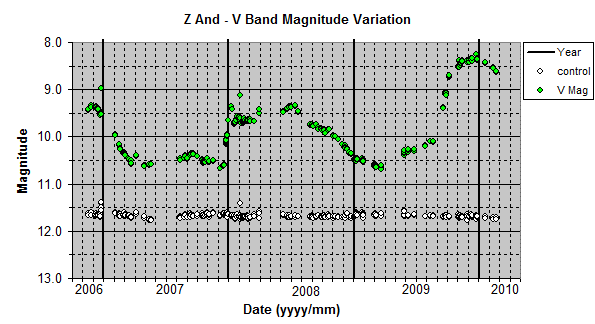
|
||
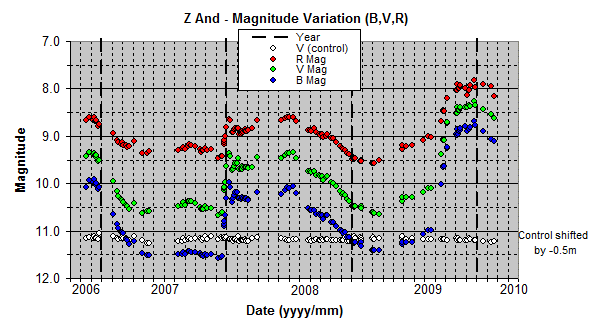
|
||
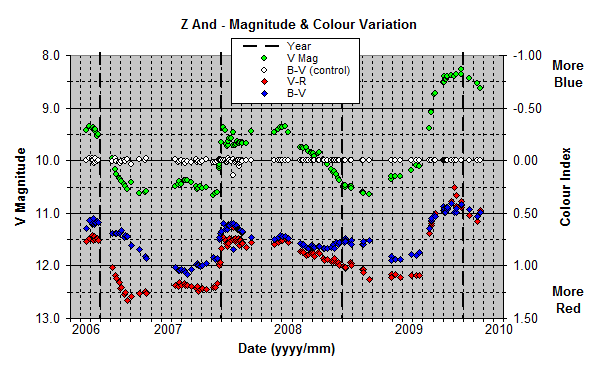
|
||
| Further observations will be made during future sessions in order to further refine the light / colour variation. |
||
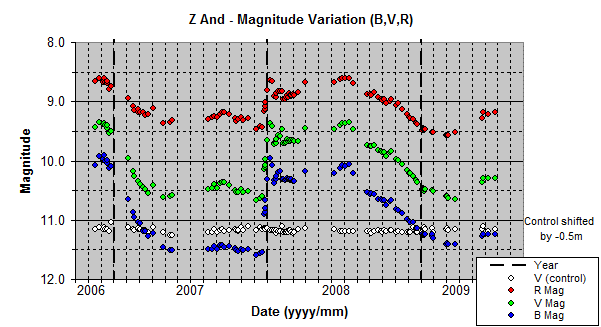
|
||
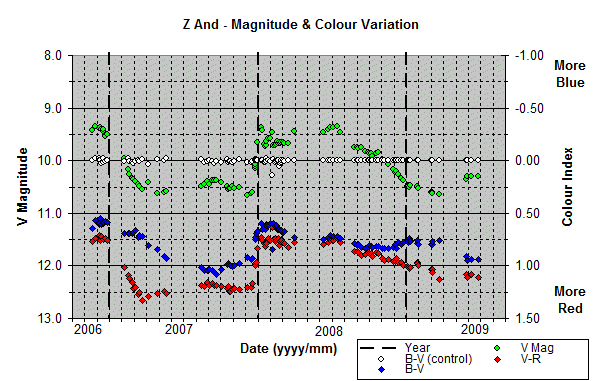
|
||
| Z And - Colour Variation | ||

|

|
|
Back to Top
|
CI Cyg (Cygnus) |
|
|
|
Annotated CCD Image |
|
|
| CI Cyg - reference stars |
|
|
| Annotated CCD Image 20s exposure, 2x2 binning, V filter, 2008-09-27 22:01h UT (#306173) |
| CI Cyg - Variation |
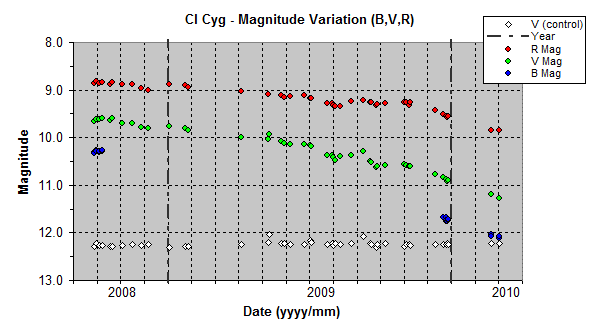
|
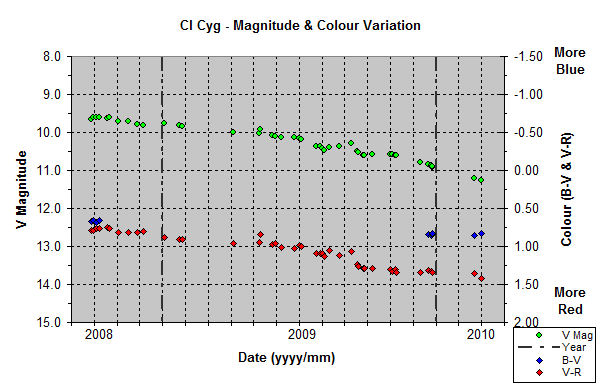
|
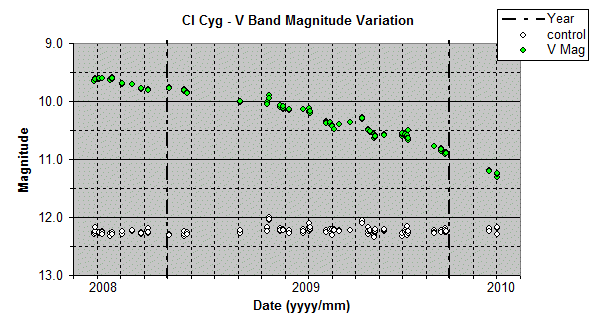
|
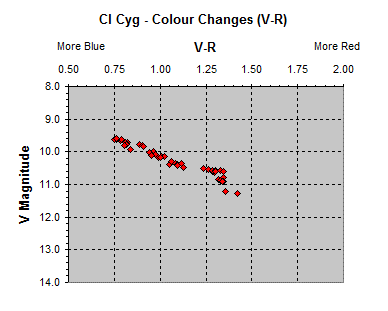
|
Back to Top
|
UX UMa (Ursa Major) |
|
|
| Annotated CCD Image 3 x 60s exposure (average combine), 2x2 binning, C filter, 2007-03-12 23:47h UT (#182279-832) |
| UX UMa - reference stars |
|
|
| Annotated CCD Image 120s exposure, 2x2 binning, V filter, 2007-03-12 23:49h UT (#182282) |
| UX UMa Variation (2007) |
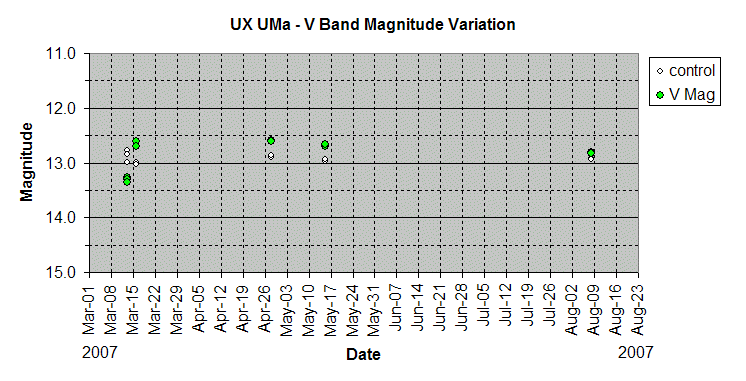
|
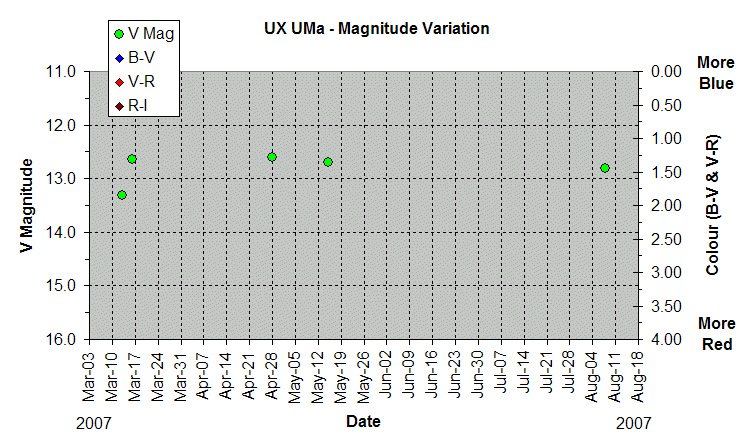
|
Back to Top
|
KR Aur (Auriga) |
|
|
| Annotated CCD Image 3 x 60s exposure (average combine), 2x2 binning, C filter, 2007-03-12 22:00h UT (#182206-10) |
| KR Aur - reference stars |
|
|
| Annotated CCD Image 120s exposure, 2x2 binning, V filter, 2007-03-12 22:02h UT (#182209) |
| KR Aur Variation (2007) |
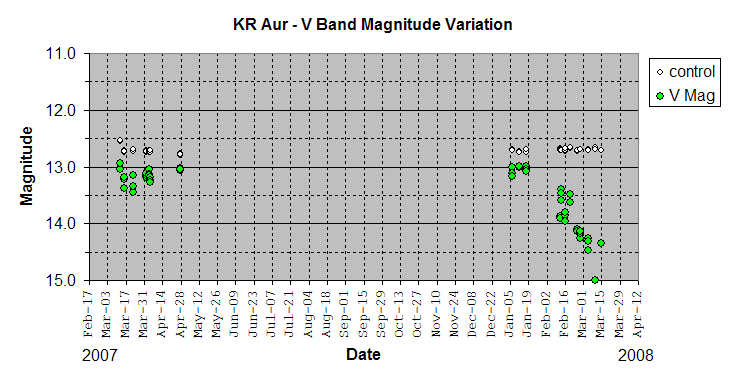
|
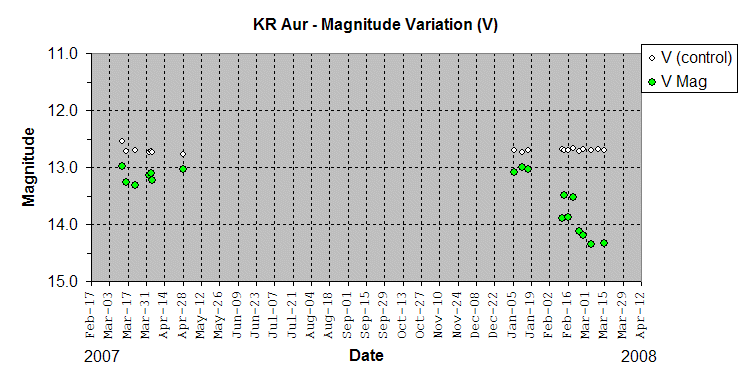
|
Back to Top
|
AM CVn (Canes Venatici) |
|
|
| Annotated CCD Image 3 x 60s exposure (average combine), 2x2 binning, C filter, 2007-03-12 22:25h UT (#182222-24) |
| AM CVn - reference stars |
|
|
| Annotated CCD Image 120s exposure, 2x2 binning, V filter, 2007-03-12 22:31h UT (#182229) |
| AM CVn Variation (2007) |
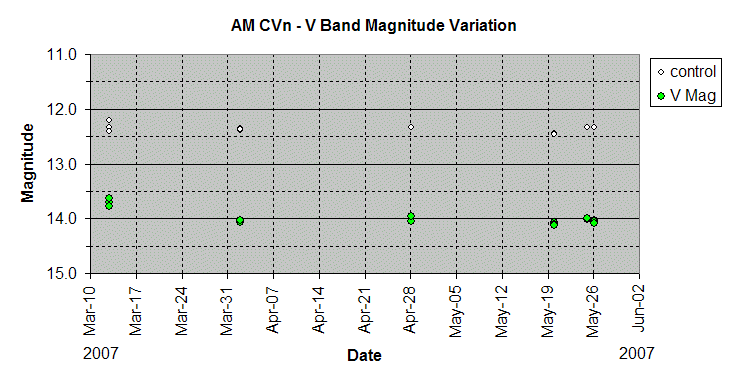
|
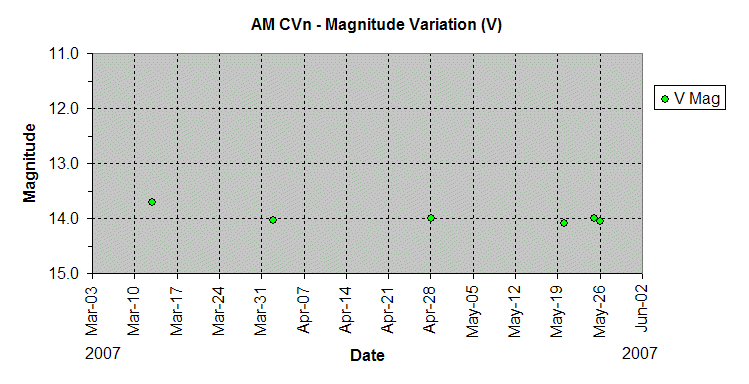
|
Back to Top
| FG Sge (Sagitta) (FG Sge appeared as AAVSO's Variable Star of the Month for June 2008 (goto article) |
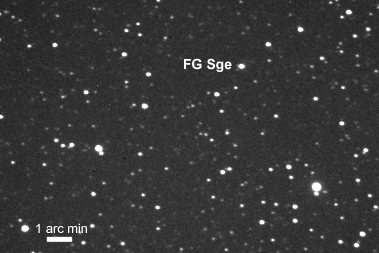
|
| Annotated CCD Image 3 x 60 sec exposure (average combine), 2x2 binning, C Filter 2008-08-26 02:54 UT (#297312-14) |
| FG Sge - reference stars |
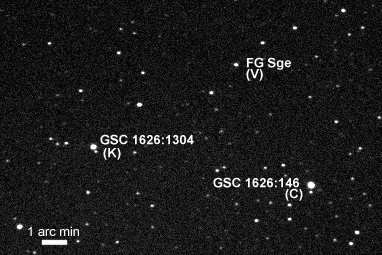
|
| Annotated CCD Image 60 sec exposure, 2x2 binning, V Filter 2008-08-26 02:46 UT (#297306) |
| FG Sge - variation |
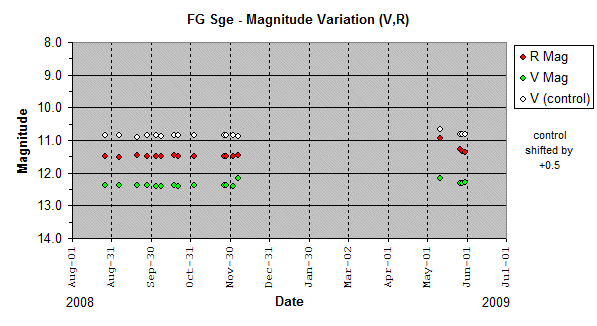
|
Back to Top
| This Web Page: | Cataclysmic Variable Stars |
| Last Updated : | 2015-05-15 |
| Site Owner : | David Richards |
| Home Page : | David's Astronomy Web Site |